
raglite
🥤 RAGLite is a Python toolkit for Retrieval-Augmented Generation (RAG) with DuckDB or PostgreSQL
Stars: 1061

RAGLite is a Python toolkit for Retrieval-Augmented Generation (RAG) with PostgreSQL or SQLite. It offers configurable options for choosing LLM providers, database types, and rerankers. The toolkit is fast and permissive, utilizing lightweight dependencies and hardware acceleration. RAGLite provides features like PDF to Markdown conversion, multi-vector chunk embedding, optimal semantic chunking, hybrid search capabilities, adaptive retrieval, and improved output quality. It is extensible with a built-in Model Context Protocol server, customizable ChatGPT-like frontend, document conversion to Markdown, and evaluation tools. Users can configure RAGLite for various tasks like configuring, inserting documents, running RAG pipelines, computing query adapters, evaluating performance, running MCP servers, and serving frontends.
README:
RAGLite is a Python toolkit for Retrieval-Augmented Generation (RAG) with DuckDB or PostgreSQL.
- 🧠 Choose any LLM provider with LiteLLM, including local llama-cpp-python models
- 💾 Choose either DuckDB or PostgreSQL as a keyword & vector search database
- 🥇 Choose any reranker with rerankers, including multilingual FlashRank as the default
- ❤️ Only lightweight and permissive open source dependencies (e.g., no PyTorch or LangChain)
- 🚀 Acceleration with Metal on macOS, and CUDA on Linux and Windows
- 📖 PDF to Markdown conversion on top of pdftext and pypdfium2
- 🧬 Multi-vector chunk embedding with late chunking and contextual chunk headings
- ✏️ Optimal sentence splitting with wtpsplit-lite by solving a binary integer programming problem
- ✂️ Optimal semantic chunking by solving a binary integer programming problem
- 🔍 Hybrid search with the database's native keyword & vector search (FTS+VSS; tsvector+pgvector)
- 💭 Adaptive retrieval where the LLM decides whether to and what to retrieve based on the query
- 💰 Improved cost and latency with a prompt caching-aware message array structure
- 🍰 Improved output quality with Anthropic's long-context prompt format
- 🌀 Optimal closed-form linear query adapter by solving an orthogonal Procrustes problem
- 🔌 A built-in Model Context Protocol (MCP) server that any MCP client like Claude desktop can connect with
- 💬 Optional customizable ChatGPT-like frontend for web, Slack, and Teams with Chainlit
- ✍️ Optional conversion of any input document to Markdown with Pandoc
- ✅ Optional evaluation of retrieval and generation performance with Ragas
[!TIP] 🚀 If you want to use local models, it is recommended to install an accelerated llama-cpp-python precompiled binary with:
# Configure which llama-cpp-python precompiled binary to install (⚠️ not every combination is available): LLAMA_CPP_PYTHON_VERSION=0.3.9 PYTHON_VERSION=310|311|312 ACCELERATOR=metal|cu121|cu122|cu123|cu124 PLATFORM=macosx_11_0_arm64|linux_x86_64|win_amd64 # Install llama-cpp-python: pip install "https://github.com/abetlen/llama-cpp-python/releases/download/v$LLAMA_CPP_PYTHON_VERSION-$ACCELERATOR/llama_cpp_python-$LLAMA_CPP_PYTHON_VERSION-cp$PYTHON_VERSION-cp$PYTHON_VERSION-$PLATFORM.whl"
Install RAGLite with:
pip install ragliteTo add support for a customizable ChatGPT-like frontend, use the chainlit extra:
pip install raglite[chainlit]To add support for filetypes other than PDF, use the pandoc extra:
pip install raglite[pandoc]To add support for evaluation, use the ragas extra:
pip install raglite[ragas]- Configuring RAGLite
- Inserting documents
- Retrieval-Augmented Generation (RAG)
- Computing and using an optimal query adapter
- Evaluation of retrieval and generation
- Running a Model Context Protocol (MCP) server
- Serving a customizable ChatGPT-like frontend
[!TIP] 🧠 RAGLite extends LiteLLM with support for llama.cpp models using llama-cpp-python. To select a llama.cpp model (e.g., from Unsloth's collection), use a model identifier of the form
"llama-cpp-python/<hugging_face_repo_id>/<filename>@<n_ctx>", wheren_ctxis an optional parameter that specifies the context size of the model.
[!TIP] 💾 You can create a PostgreSQL database in a few clicks at neon.tech.
First, configure RAGLite with your preferred DuckDB or PostgreSQL database and any LLM supported by LiteLLM:
from raglite import RAGLiteConfig
# Example 'remote' config with a PostgreSQL database and an OpenAI LLM:
my_config = RAGLiteConfig(
db_url="postgresql://my_username:my_password@my_host:5432/my_database",
llm="gpt-4o-mini", # Or any LLM supported by LiteLLM
embedder="text-embedding-3-large", # Or any embedder supported by LiteLLM
)
# Example 'local' config with a DuckDB database and a llama.cpp LLM:
my_config = RAGLiteConfig(
db_url="duckdb:///raglite.db",
llm="llama-cpp-python/unsloth/Qwen3-8B-GGUF/*Q4_K_M.gguf@8192",
embedder="llama-cpp-python/lm-kit/bge-m3-gguf/*F16.gguf@512", # More than 512 tokens degrades bge-m3's performance
)You can also configure any reranker supported by rerankers:
from rerankers import Reranker
# Example remote API-based reranker:
my_config = RAGLiteConfig(
db_url="postgresql://my_username:my_password@my_host:5432/my_database"
reranker=Reranker("rerank-v3.5", model_type="cohere", api_key=COHERE_API_KEY, verbose=0) # Multilingual
)
# Example local cross-encoder reranker per language (this is the default):
my_config = RAGLiteConfig(
db_url="duckdb:///raglite.db",
reranker={
"en": Reranker("ms-marco-MiniLM-L-12-v2", model_type="flashrank", verbose=0), # English
"other": Reranker("ms-marco-MultiBERT-L-12", model_type="flashrank", verbose=0), # Other languages
}
)[!TIP] ✍️ To insert documents other than PDF, install the
pandocextra withpip install raglite[pandoc].
Next, insert some documents into the database. RAGLite will take care of the conversion to Markdown, optimal level 4 semantic chunking, and multi-vector embedding with late chunking:
# Insert documents given their file path
from pathlib import Path
from raglite import Document, insert_documents
documents = [
Document.from_path(Path("On the Measure of Intelligence.pdf")),
Document.from_path(Path("Special Relativity.pdf")),
]
insert_documents(documents, config=my_config)
# Insert documents given their text/plain or text/markdown content
content = """
# ON THE ELECTRODYNAMICS OF MOVING BODIES
## By A. EINSTEIN June 30, 1905
It is known that Maxwell...
"""
documents = [
Document.from_text(content)
]
insert_documents(documents, config=my_config)Now you can run an adaptive RAG pipeline that consists of adding the user prompt to the message history and streaming the LLM response:
from raglite import rag
# Create a user message
messages = [] # Or start with an existing message history
messages.append({
"role": "user",
"content": "How is intelligence measured?"
})
# Adaptively decide whether to retrieve and then stream the response
chunk_spans = []
stream = rag(messages, on_retrieval=lambda x: chunk_spans.extend(x), config=my_config)
for update in stream:
print(update, end="")
# Access the documents referenced in the RAG context
documents = [chunk_span.document for chunk_span in chunk_spans]The LLM will adaptively decide whether to retrieve information based on the complexity of the user prompt. If retrieval is necessary, the LLM generates the search query and RAGLite applies hybrid search and reranking to retrieve the most relevant chunk spans (each of which is a list of consecutive chunks). The retrieval results are sent to the on_retrieval callback and are appended to the message history as a tool output. Finally, the assistant response is streamed and appended to the message history.
If you need manual control over the RAG pipeline, you can run a basic but powerful pipeline that consists of retrieving the most relevant chunk spans with hybrid search and reranking, converting the user prompt to a RAG instruction and appending it to the message history, and finally generating the RAG response:
from raglite import add_context, rag, retrieve_context, vector_search
# Choose a search method
from dataclasses import replace
my_config = replace(my_config, search_method=vector_search) # Or `hybrid_search`, `search_and_rerank_chunks`, ...
# Retrieve relevant chunk spans with the configured search method
user_prompt = "How is intelligence measured?"
chunk_spans = retrieve_context(query=user_prompt, num_chunks=5, config=my_config)
# Append a RAG instruction based on the user prompt and context to the message history
messages = [] # Or start with an existing message history
messages.append(add_context(user_prompt=user_prompt, context=chunk_spans))
# Stream the RAG response and append it to the message history
stream = rag(messages, config=my_config)
for update in stream:
print(update, end="")
# Access the documents referenced in the RAG context
documents = [chunk_span.document for chunk_span in chunk_spans][!TIP] 🥇 Reranking can significantly improve the output quality of a RAG application. To add reranking to your application: first search for a larger set of 20 relevant chunks, then rerank them with a rerankers reranker, and finally keep the top 5 chunks.
RAGLite also offers more advanced control over the individual steps of a full RAG pipeline:
- Searching for relevant chunks with keyword, vector, or hybrid search
- Retrieving the chunks from the database
- Reranking the chunks and selecting the top 5 results
- Extending the chunks with their neighbors and grouping them into chunk spans
- Converting the user prompt to a RAG instruction and appending it to the message history
- Streaming an LLM response to the message history
- Accessing the cited documents from the chunk spans
A full RAG pipeline is straightforward to implement with RAGLite:
# Search for chunks
from raglite import hybrid_search, keyword_search, vector_search
user_prompt = "How is intelligence measured?"
chunk_ids_vector, _ = vector_search(user_prompt, num_results=20, config=my_config)
chunk_ids_keyword, _ = keyword_search(user_prompt, num_results=20, config=my_config)
chunk_ids_hybrid, _ = hybrid_search(user_prompt, num_results=20, config=my_config)
# Retrieve chunks
from raglite import retrieve_chunks
chunks_hybrid = retrieve_chunks(chunk_ids_hybrid, config=my_config)
# Rerank chunks and keep the top 5 (optional, but recommended)
from raglite import rerank_chunks
chunks_reranked = rerank_chunks(user_prompt, chunks_hybrid, config=my_config)
chunks_reranked = chunks_reranked[:5]
# Extend chunks with their neighbors and group them into chunk spans
from raglite import retrieve_chunk_spans
chunk_spans = retrieve_chunk_spans(chunks_reranked, config=my_config)
# Append a RAG instruction based on the user prompt and context to the message history
from raglite import add_context
messages = [] # Or start with an existing message history
messages.append(add_context(user_prompt=user_prompt, context=chunk_spans))
# Stream the RAG response and append it to the message history
from raglite import rag
stream = rag(messages, config=my_config)
for update in stream:
print(update, end="")
# Access the documents referenced in the RAG context
documents = [chunk_span.document for chunk_span in chunk_spans]RAGLite can compute and apply an optimal closed-form query adapter to the prompt embedding to improve the output quality of RAG. To benefit from this, first generate a set of evals with insert_evals and then compute and store the optimal query adapter with update_query_adapter:
# Improve RAG with an optimal query adapter
from raglite import insert_evals, update_query_adapter
insert_evals(num_evals=100, config=my_config)
update_query_adapter(config=my_config) # From here, every vector search will use the query adapterIf you installed the ragas extra, you can use RAGLite to answer the evals and then evaluate the quality of both the retrieval and generation steps of RAG using Ragas:
# Evaluate retrieval and generation
from raglite import answer_evals, evaluate, insert_evals
insert_evals(num_evals=100, config=my_config)
answered_evals_df = answer_evals(num_evals=10, config=my_config)
evaluation_df = evaluate(answered_evals_df, config=my_config)RAGLite comes with an MCP server implemented with FastMCP that exposes a search_knowledge_base tool. To use the server:
- Install Claude desktop
- Install uv so that Claude desktop can start the server
- Configure Claude desktop to use
uvto start the MCP server with:
raglite \
--db-url duckdb:///raglite.db \
--llm llama-cpp-python/unsloth/Qwen3-4B-GGUF/*Q4_K_M.gguf@8192 \
--embedder llama-cpp-python/lm-kit/bge-m3-gguf/*F16.gguf@512 \
mcp install
To use an API-based LLM, make sure to include your credentials in a .env file or supply them inline:
export OPENAI_API_KEY=sk-...
raglite \
--llm gpt-4o-mini \
--embedder text-embedding-3-large \
mcp installNow, when you start Claude desktop you should see a 🔨 icon at the bottom right of your prompt indicating that the Claude has successfully connected with the MCP server.
When relevant, Claude will suggest to use the search_knowledge_base tool that the MCP server provides. You can also explicitly ask Claude to search the knowledge base if you want to be certain that it does.
If you installed the chainlit extra, you can serve a customizable ChatGPT-like frontend with:
raglite chainlitThe application is also deployable to web, Slack, and Teams.
You can specify the database URL, LLM, and embedder directly in the Chainlit frontend, or with the CLI as follows:
raglite \
--db-url duckdb:///raglite.db \
--llm llama-cpp-python/unsloth/Qwen3-4B-GGUF/*Q4_K_M.gguf@8192 \
--embedder llama-cpp-python/lm-kit/bge-m3-gguf/*F16.gguf@512 \
chainlitTo use an API-based LLM, make sure to include your credentials in a .env file or supply them inline:
OPENAI_API_KEY=sk-... raglite --llm gpt-4o-mini --embedder text-embedding-3-large chainlitPrerequisites
-
Generate an SSH key and add the SSH key to your GitHub account.
-
Configure SSH to automatically load your SSH keys:
cat << EOF >> ~/.ssh/config Host * AddKeysToAgent yes IgnoreUnknown UseKeychain UseKeychain yes ForwardAgent yes EOF
-
Install VS Code and VS Code's Dev Containers extension. Alternatively, install PyCharm.
-
Optional: install a Nerd Font such as FiraCode Nerd Font and configure VS Code or PyCharm to use it.
Development environments
The following development environments are supported:
-
⭐️ GitHub Codespaces: click on Open in GitHub Codespaces to start developing in your browser.
-
⭐️ VS Code Dev Container (with container volume): click on Open in Dev Containers to clone this repository in a container volume and create a Dev Container with VS Code.
-
⭐️ uv: clone this repository and run the following from root of the repository:
# Create and install a virtual environment uv sync --python 3.10 --all-extras # Activate the virtual environment source .venv/bin/activate # Install the pre-commit hooks pre-commit install --install-hooks
-
VS Code Dev Container: clone this repository, open it with VS Code, and run Ctrl/⌘ + ⇧ + P → Dev Containers: Reopen in Container.
-
PyCharm Dev Container: clone this repository, open it with PyCharm, create a Dev Container with Mount Sources, and configure an existing Python interpreter at
/opt/venv/bin/python.
Developing
- This project follows the Conventional Commits standard to automate Semantic Versioning and Keep A Changelog with Commitizen.
- Run
poefrom within the development environment to print a list of Poe the Poet tasks available to run on this project. - Run
uv add {package}from within the development environment to install a run time dependency and add it topyproject.tomlanduv.lock. Add--devto install a development dependency. - Run
uv sync --upgradefrom within the development environment to upgrade all dependencies to the latest versions allowed bypyproject.toml. Add--only-devto upgrade the development dependencies only. - Run
cz bumpto bump the package's version, update theCHANGELOG.md, and create a git tag. Then push the changes and the git tag withgit push origin main --tags.
For Tasks:
Click tags to check more tools for each tasksFor Jobs:
Alternative AI tools for raglite
Similar Open Source Tools

raglite
RAGLite is a Python toolkit for Retrieval-Augmented Generation (RAG) with PostgreSQL or SQLite. It offers configurable options for choosing LLM providers, database types, and rerankers. The toolkit is fast and permissive, utilizing lightweight dependencies and hardware acceleration. RAGLite provides features like PDF to Markdown conversion, multi-vector chunk embedding, optimal semantic chunking, hybrid search capabilities, adaptive retrieval, and improved output quality. It is extensible with a built-in Model Context Protocol server, customizable ChatGPT-like frontend, document conversion to Markdown, and evaluation tools. Users can configure RAGLite for various tasks like configuring, inserting documents, running RAG pipelines, computing query adapters, evaluating performance, running MCP servers, and serving frontends.
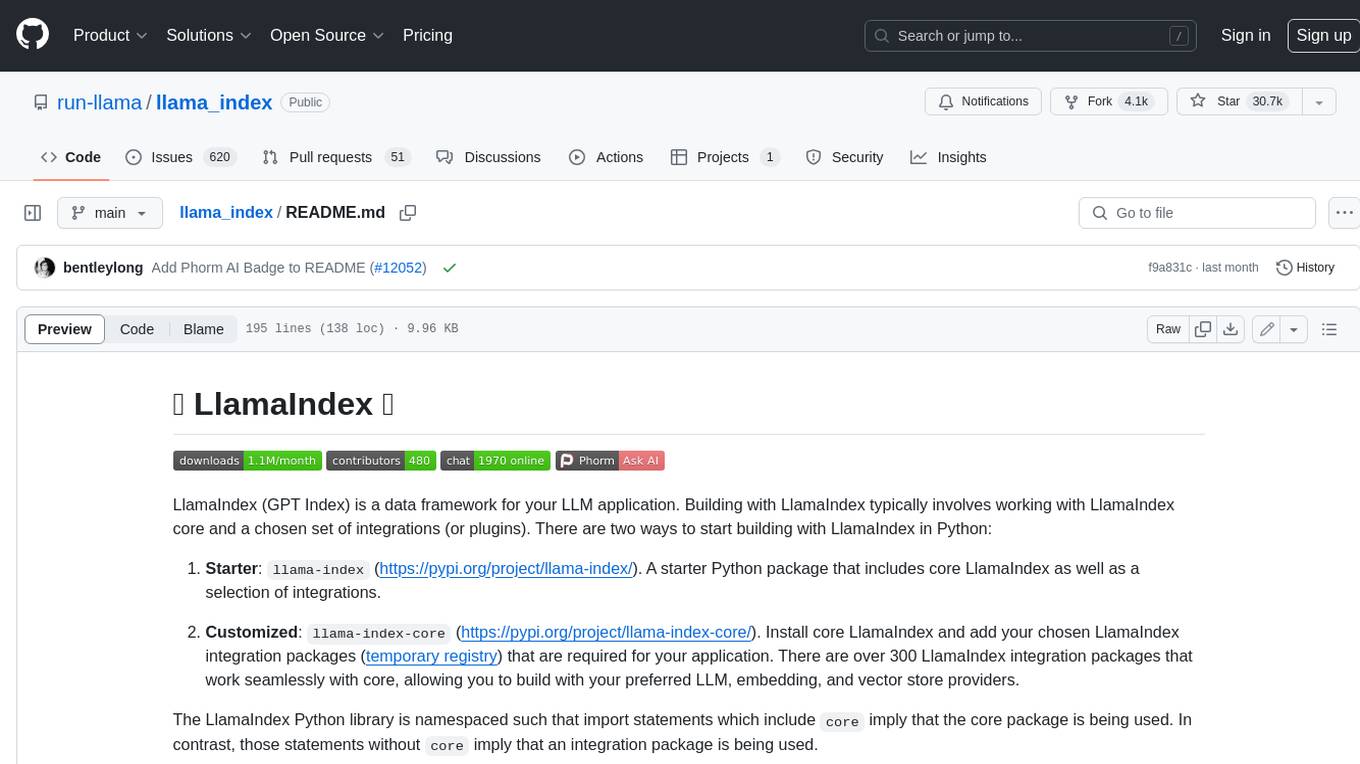
llama_index
LlamaIndex is a data framework for building LLM applications. It provides tools for ingesting, structuring, and querying data, as well as integrating with LLMs and other tools. LlamaIndex is designed to be easy to use for both beginner and advanced users, and it provides a comprehensive set of features for building LLM applications.
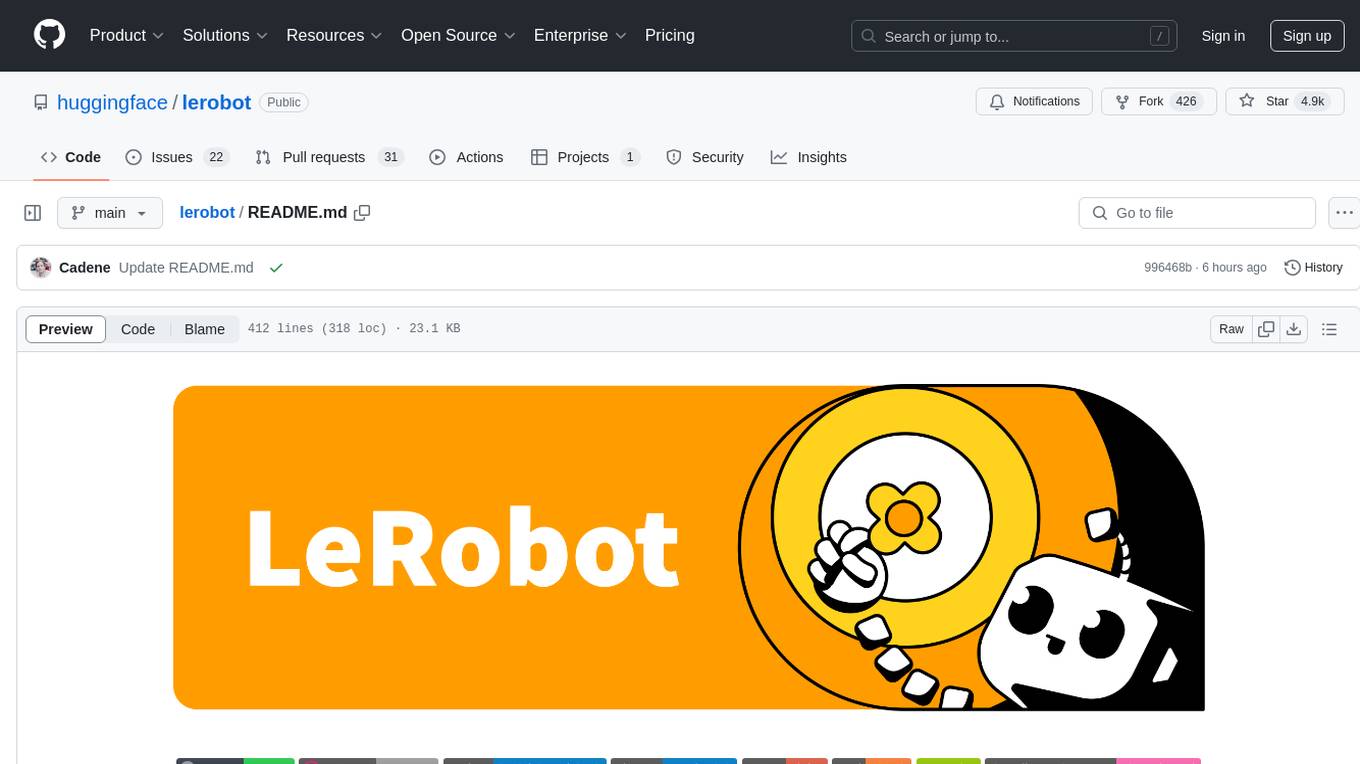
lerobot
LeRobot is a state-of-the-art AI library for real-world robotics in PyTorch. It aims to provide models, datasets, and tools to lower the barrier to entry to robotics, focusing on imitation learning and reinforcement learning. LeRobot offers pretrained models, datasets with human-collected demonstrations, and simulation environments. It plans to support real-world robotics on affordable and capable robots. The library hosts pretrained models and datasets on the Hugging Face community page.
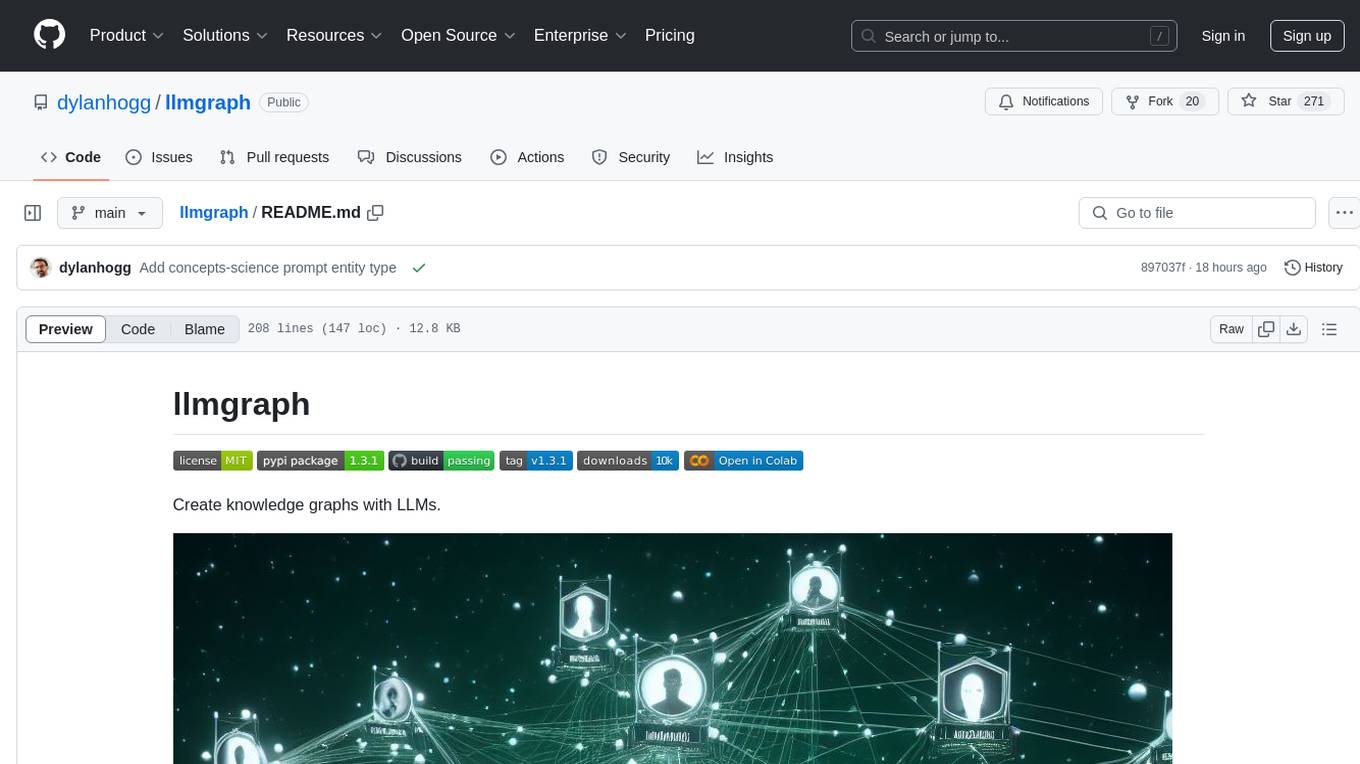
llmgraph
llmgraph is a tool that enables users to create knowledge graphs in GraphML, GEXF, and HTML formats by extracting world knowledge from large language models (LLMs) like ChatGPT. It supports various entity types and relationships, offers cache support for efficient graph growth, and provides insights into LLM costs. Users can customize the model used and interact with different LLM providers. The tool allows users to generate interactive graphs based on a specified entity type and Wikipedia link, making it a valuable resource for knowledge graph creation and exploration.
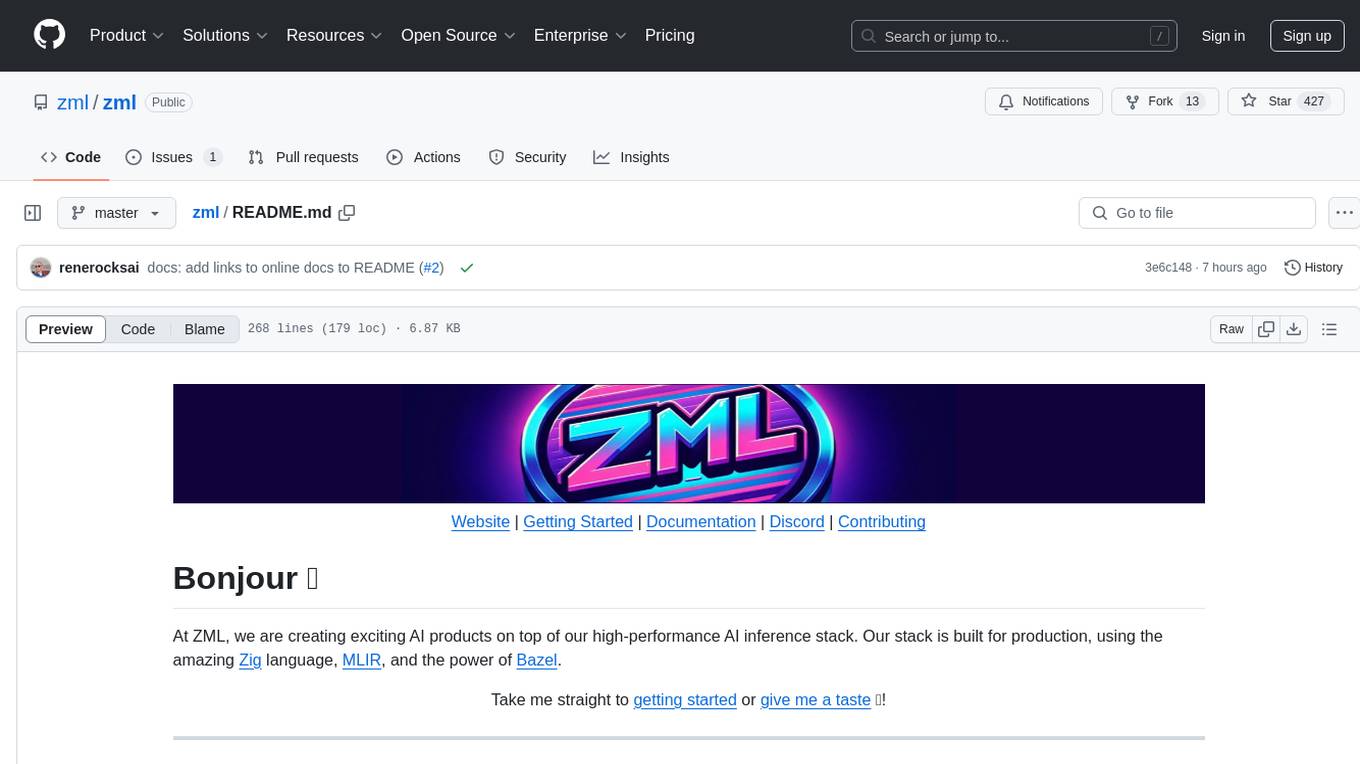
zml
ZML is a high-performance AI inference stack built for production, using Zig language, MLIR, and Bazel. It allows users to create exciting AI projects, run pre-packaged models like MNIST, TinyLlama, OpenLLama, and Meta Llama, and compile models for accelerator runtimes. Users can also run tests, explore examples, and contribute to the project. ZML is licensed under the Apache 2.0 license.

paxml
Pax is a framework to configure and run machine learning experiments on top of Jax.
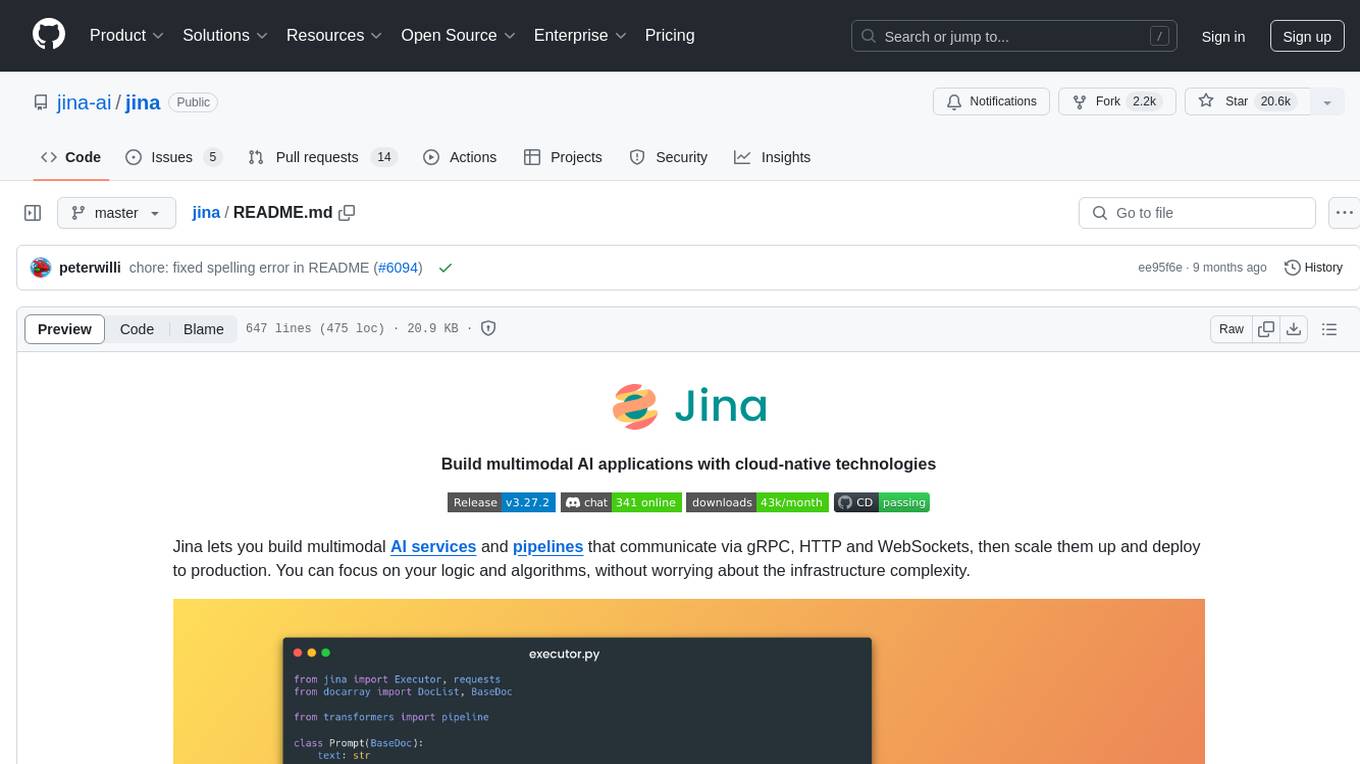
jina
Jina is a tool that allows users to build multimodal AI services and pipelines using cloud-native technologies. It provides a Pythonic experience for serving ML models and transitioning from local deployment to advanced orchestration frameworks like Docker-Compose, Kubernetes, or Jina AI Cloud. Users can build and serve models for any data type and deep learning framework, design high-performance services with easy scaling, serve LLM models while streaming their output, integrate with Docker containers via Executor Hub, and host on CPU/GPU using Jina AI Cloud. Jina also offers advanced orchestration and scaling capabilities, a smooth transition to the cloud, and easy scalability and concurrency features for applications. Users can deploy to their own cloud or system with Kubernetes and Docker Compose integration, and even deploy to JCloud for autoscaling and monitoring.
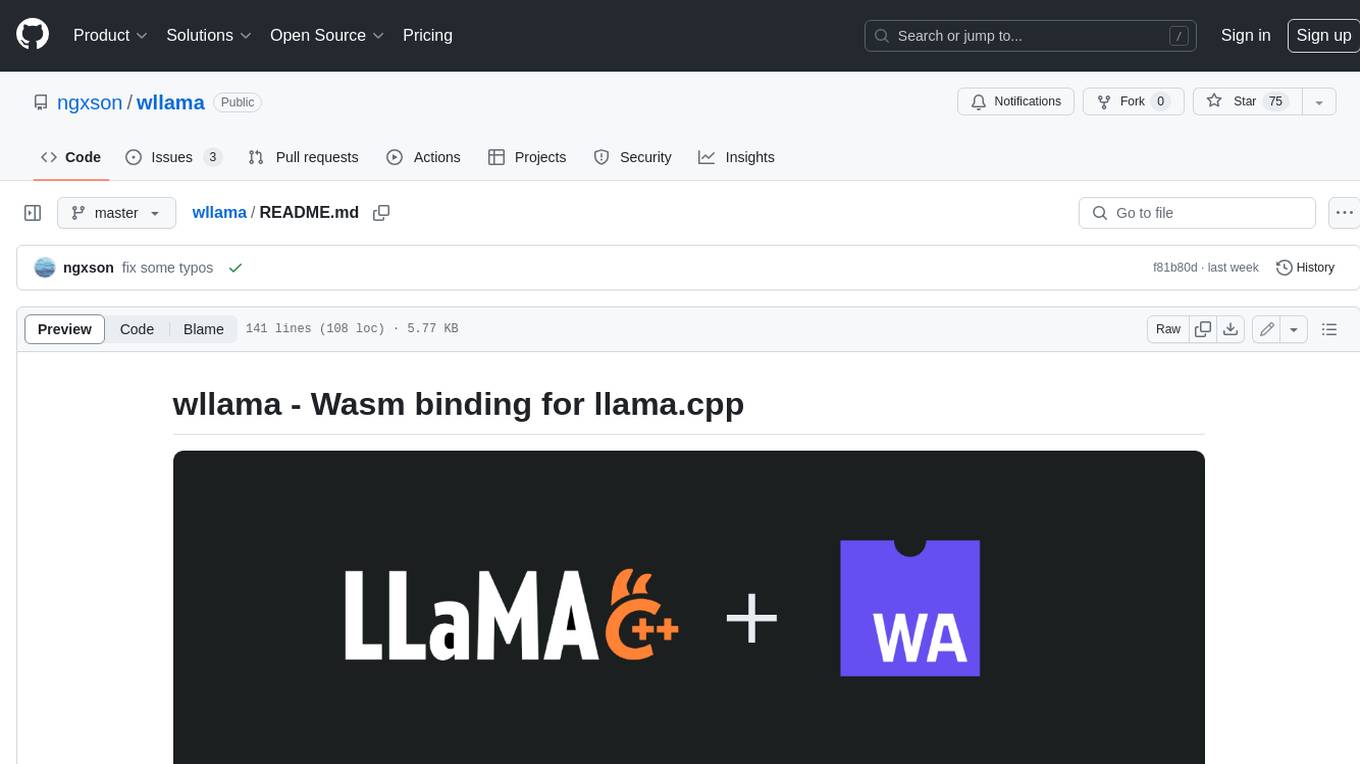
wllama
Wllama is a WebAssembly binding for llama.cpp, a high-performance and lightweight language model library. It enables you to run inference directly on the browser without the need for a backend or GPU. Wllama provides both high-level and low-level APIs, allowing you to perform various tasks such as completions, embeddings, tokenization, and more. It also supports model splitting, enabling you to load large models in parallel for faster download. With its Typescript support and pre-built npm package, Wllama is easy to integrate into your React Typescript projects.
Pixel-Reasoner
Pixel Reasoner is a framework that introduces reasoning in the pixel-space for Vision-Language Models (VLMs), enabling them to directly inspect, interrogate, and infer from visual evidences. This enhances reasoning fidelity for visual tasks by equipping VLMs with visual reasoning operations like zoom-in and select-frame. The framework addresses challenges like model's imbalanced competence and reluctance to adopt pixel-space operations through a two-phase training approach involving instruction tuning and curiosity-driven reinforcement learning. With these visual operations, VLMs can interact with complex visual inputs such as images or videos to gather necessary information, leading to improved performance across visual reasoning benchmarks.
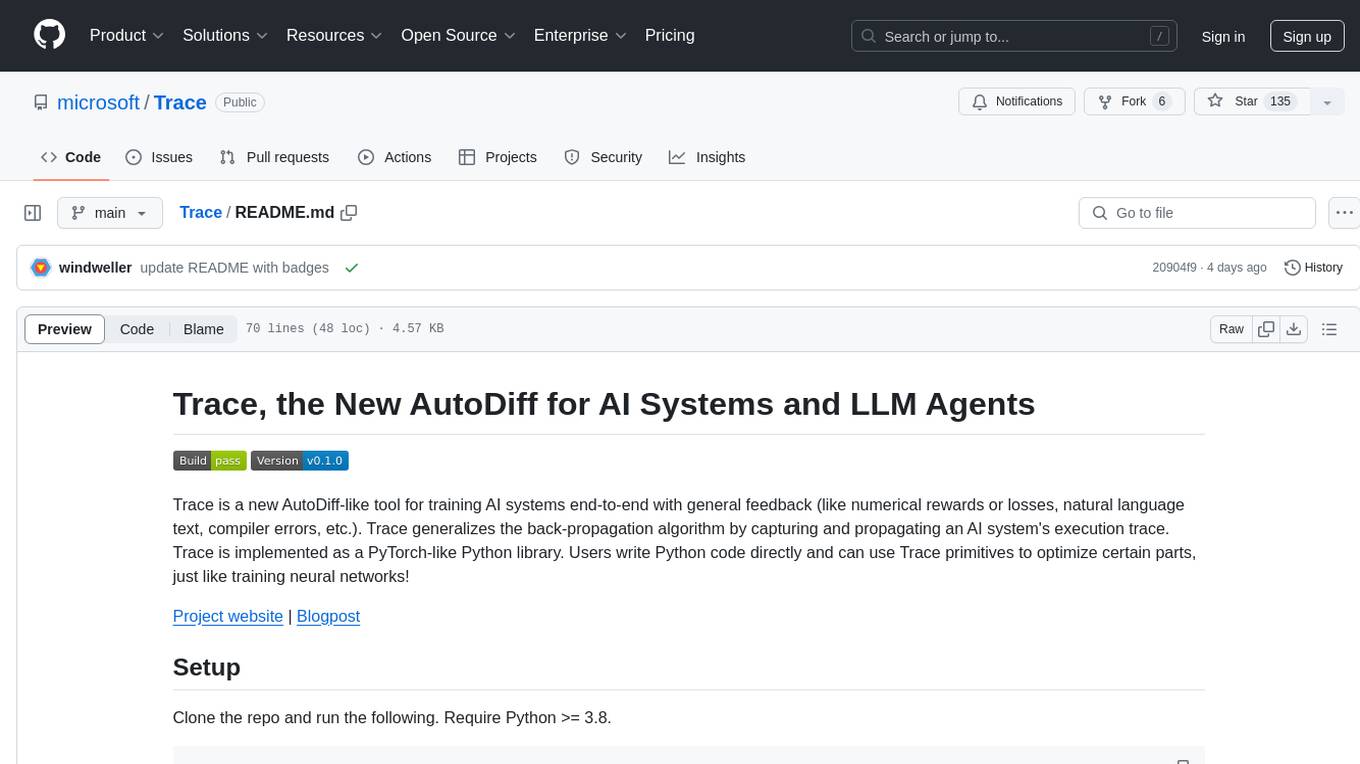
Trace
Trace is a new AutoDiff-like tool for training AI systems end-to-end with general feedback. It generalizes the back-propagation algorithm by capturing and propagating an AI system's execution trace. Implemented as a PyTorch-like Python library, users can write Python code directly and use Trace primitives to optimize certain parts, similar to training neural networks.
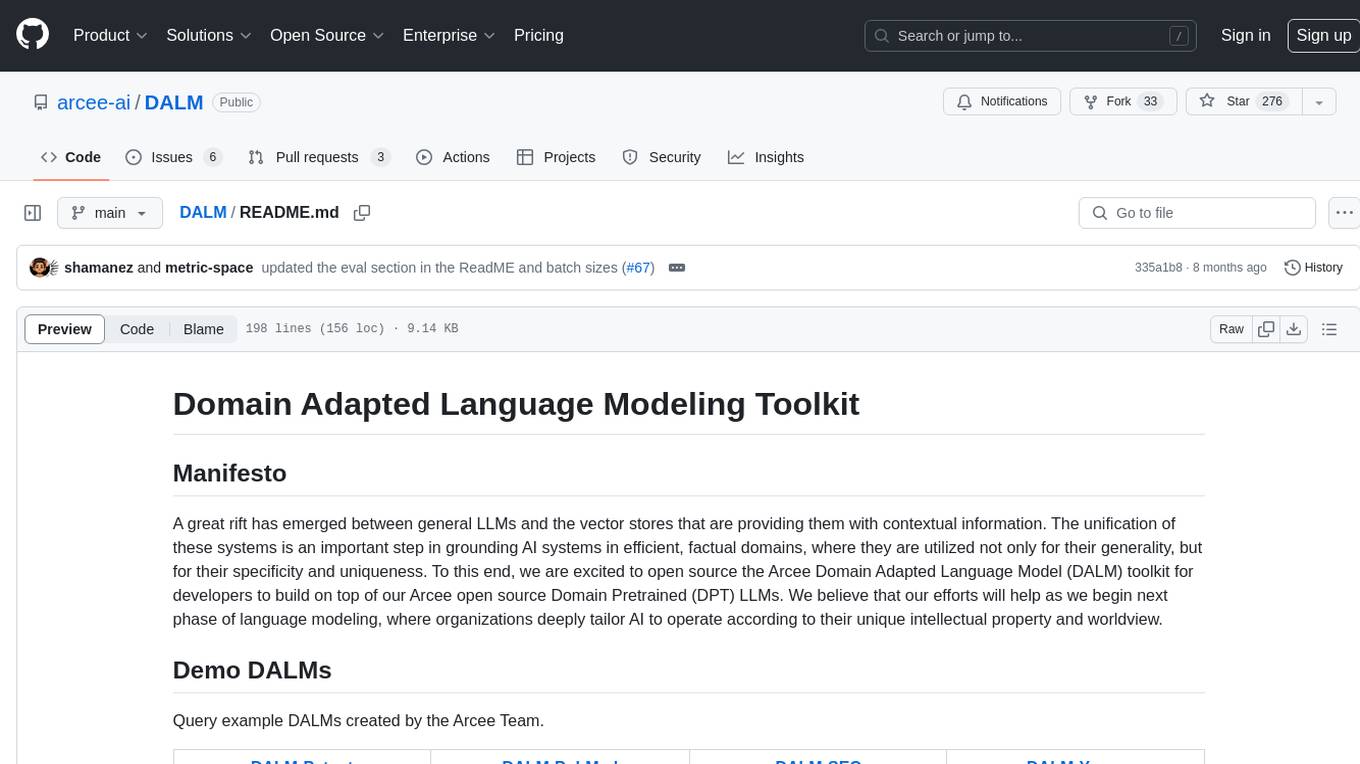
DALM
The DALM (Domain Adapted Language Modeling) toolkit is designed to unify general LLMs with vector stores to ground AI systems in efficient, factual domains. It provides developers with tools to build on top of Arcee's open source Domain Pretrained LLMs, enabling organizations to deeply tailor AI according to their unique intellectual property and worldview. The toolkit contains code for fine-tuning a fully differential Retrieval Augmented Generation (RAG-end2end) architecture, incorporating in-batch negative concept alongside RAG's marginalization for efficiency. It includes training scripts for both retriever and generator models, evaluation scripts, data processing codes, and synthetic data generation code.
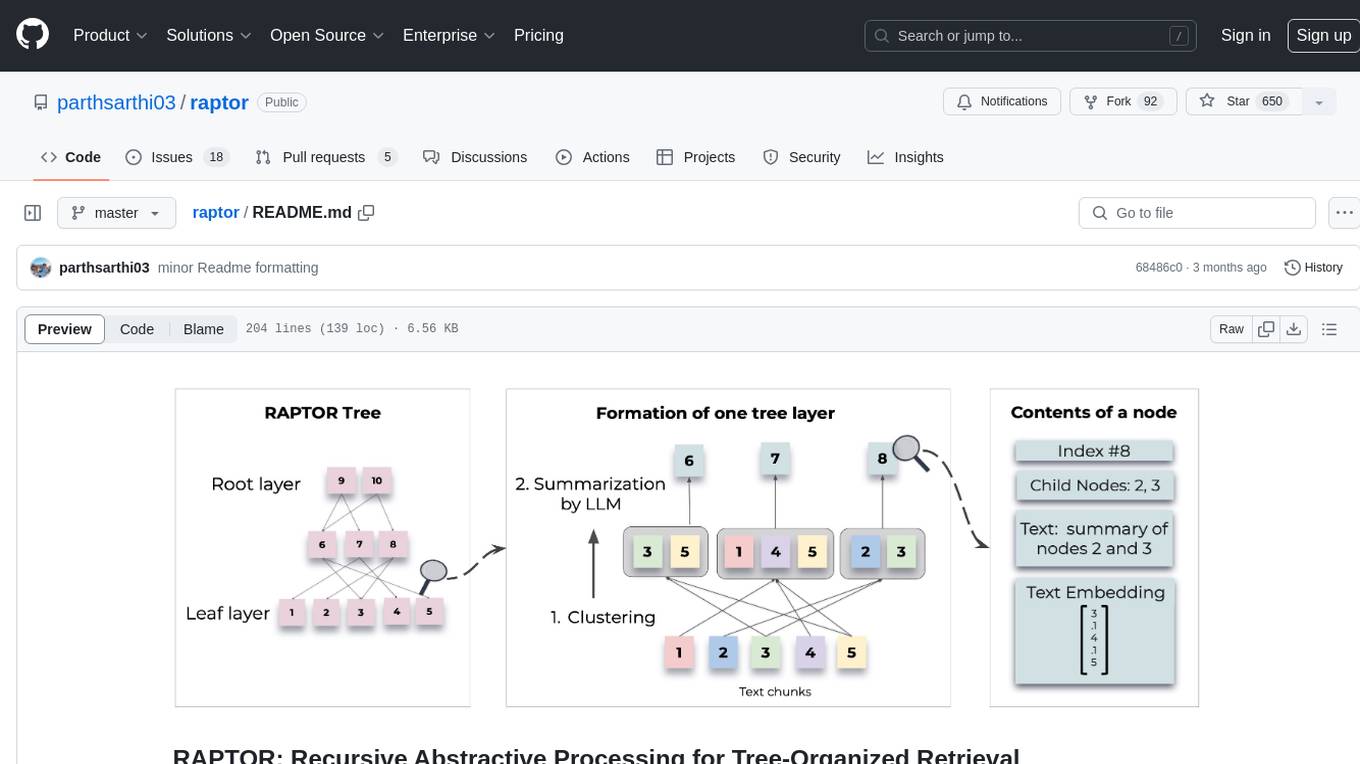
raptor
RAPTOR introduces a novel approach to retrieval-augmented language models by constructing a recursive tree structure from documents. This allows for more efficient and context-aware information retrieval across large texts, addressing common limitations in traditional language models. Users can add documents to the tree, answer questions based on indexed documents, save and load the tree, and extend RAPTOR with custom summarization, question-answering, and embedding models. The tool is designed to be flexible and customizable for various NLP tasks.
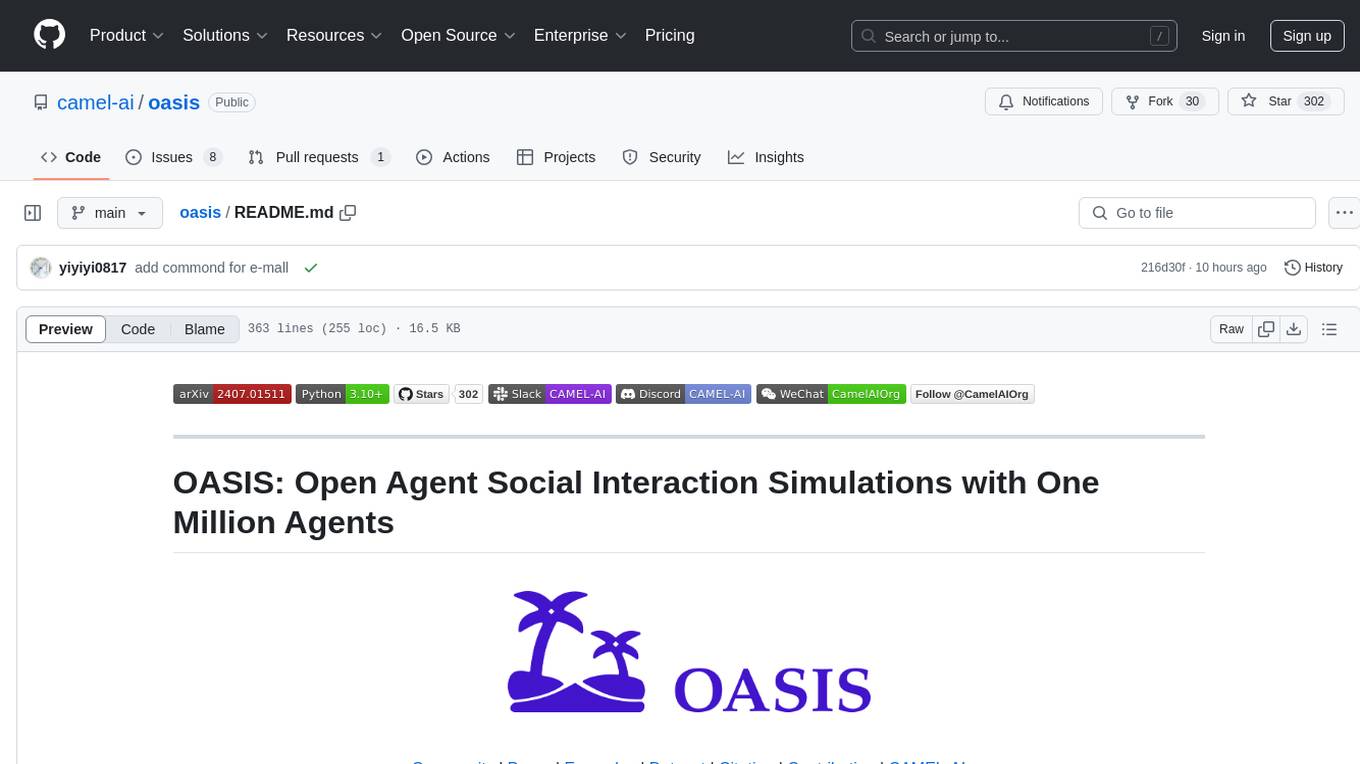
oasis
OASIS is a scalable, open-source social media simulator that integrates large language models with rule-based agents to realistically mimic the behavior of up to one million users on platforms like Twitter and Reddit. It facilitates the study of complex social phenomena such as information spread, group polarization, and herd behavior, offering a versatile tool for exploring diverse social dynamics and user interactions in digital environments. With features like scalability, dynamic environments, diverse action spaces, and integrated recommendation systems, OASIS provides a comprehensive platform for simulating social media interactions at a large scale.
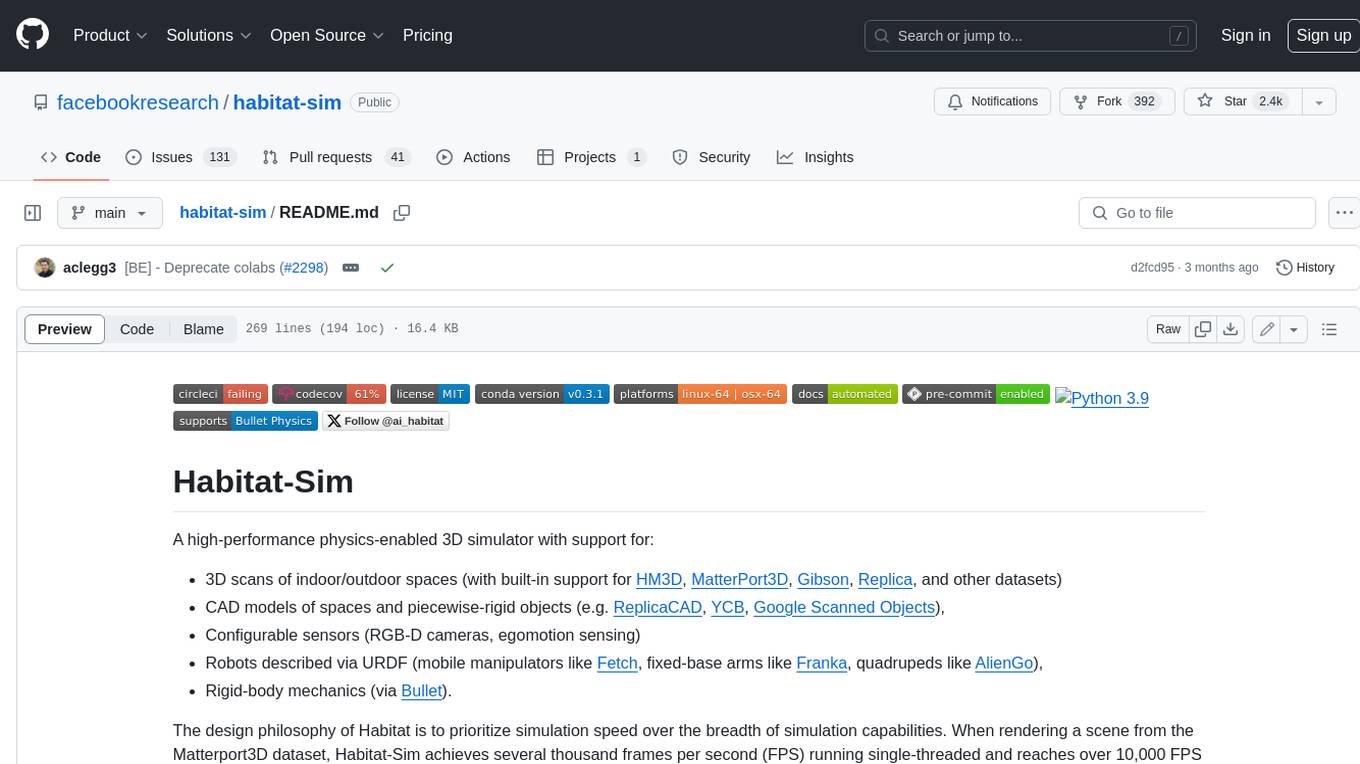
habitat-sim
Habitat-Sim is a high-performance physics-enabled 3D simulator with support for 3D scans of indoor/outdoor spaces, CAD models of spaces and piecewise-rigid objects, configurable sensors, robots described via URDF, and rigid-body mechanics. It prioritizes simulation speed over the breadth of simulation capabilities, achieving several thousand frames per second (FPS) running single-threaded and over 10,000 FPS multi-process on a single GPU when rendering a scene from the Matterport3D dataset. Habitat-Sim simulates a Fetch robot interacting in ReplicaCAD scenes at over 8,000 steps per second (SPS), where each ‘step’ involves rendering 1 RGBD observation (128×128 pixels) and rigid-body dynamics for 1/30sec.
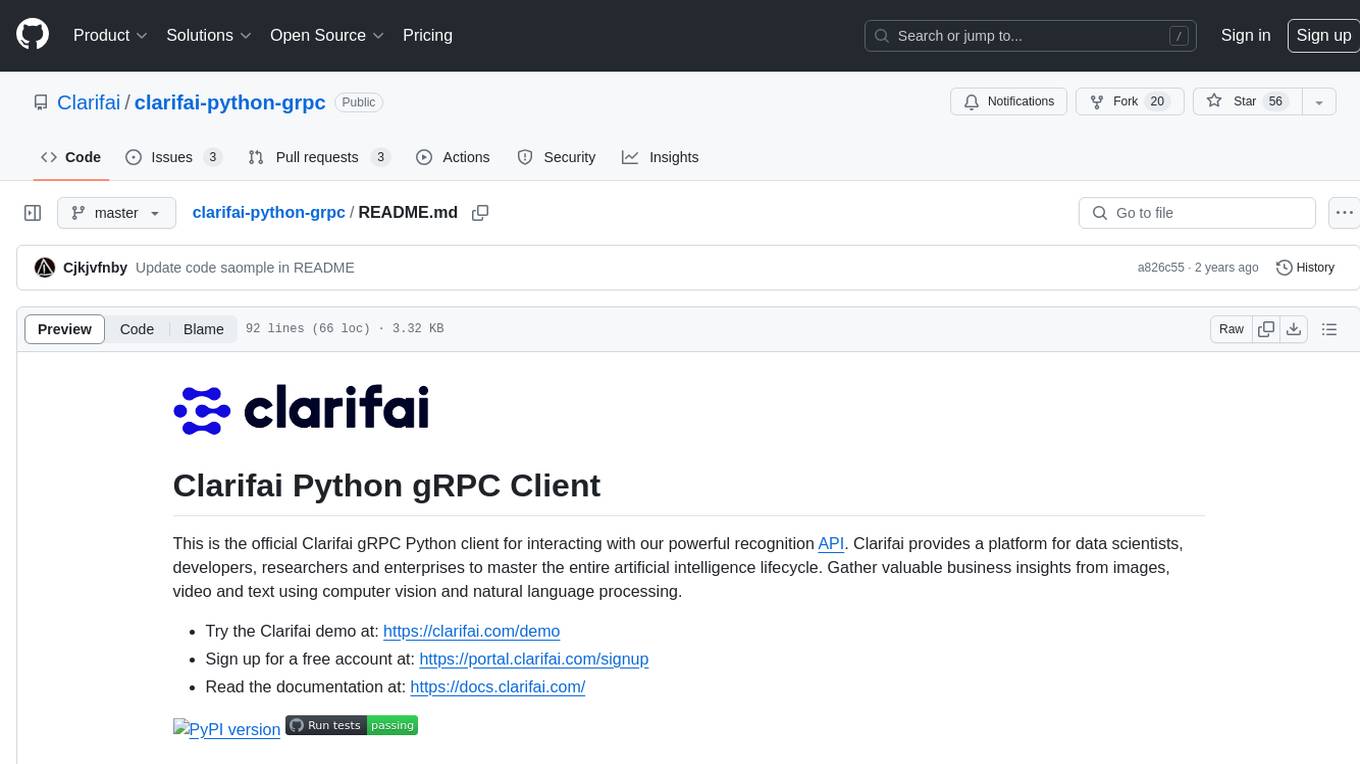
clarifai-python-grpc
This is the official Clarifai gRPC Python client for interacting with their recognition API. Clarifai offers a platform for data scientists, developers, researchers, and enterprises to utilize artificial intelligence for image, video, and text analysis through computer vision and natural language processing. The client allows users to authenticate, predict concepts in images, and access various functionalities provided by the Clarifai API. It follows a versioning scheme that aligns with the backend API updates and includes specific instructions for installation and troubleshooting. Users can explore the Clarifai demo, sign up for an account, and refer to the documentation for detailed information.

aigverse
aigverse is a Python infrastructure framework that bridges the gap between logic synthesis and AI/ML applications. It allows efficient representation and manipulation of logic circuits, making it easier to integrate logic synthesis and optimization tasks into machine learning pipelines. Built upon EPFL Logic Synthesis Libraries, particularly mockturtle, aigverse provides a high-level Python interface to state-of-the-art algorithms for And-Inverter Graph (AIG) manipulation and logic synthesis, widely used in formal verification, hardware design, and optimization tasks.
For similar tasks

raglite
RAGLite is a Python toolkit for Retrieval-Augmented Generation (RAG) with PostgreSQL or SQLite. It offers configurable options for choosing LLM providers, database types, and rerankers. The toolkit is fast and permissive, utilizing lightweight dependencies and hardware acceleration. RAGLite provides features like PDF to Markdown conversion, multi-vector chunk embedding, optimal semantic chunking, hybrid search capabilities, adaptive retrieval, and improved output quality. It is extensible with a built-in Model Context Protocol server, customizable ChatGPT-like frontend, document conversion to Markdown, and evaluation tools. Users can configure RAGLite for various tasks like configuring, inserting documents, running RAG pipelines, computing query adapters, evaluating performance, running MCP servers, and serving frontends.
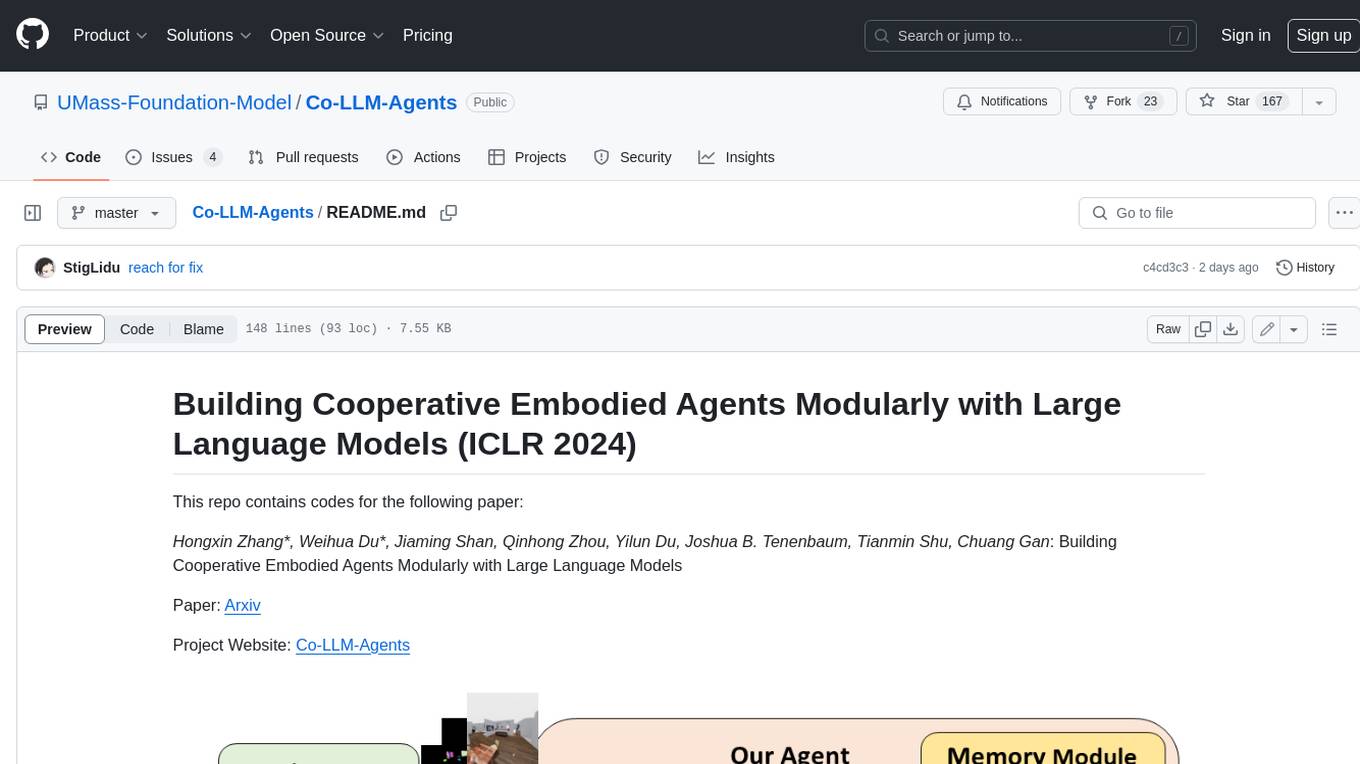
Co-LLM-Agents
This repository contains code for building cooperative embodied agents modularly with large language models. The agents are trained to perform tasks in two different environments: ThreeDWorld Multi-Agent Transport (TDW-MAT) and Communicative Watch-And-Help (C-WAH). TDW-MAT is a multi-agent environment where agents must transport objects to a goal position using containers. C-WAH is an extension of the Watch-And-Help challenge, which enables agents to send messages to each other. The code in this repository can be used to train agents to perform tasks in both of these environments.
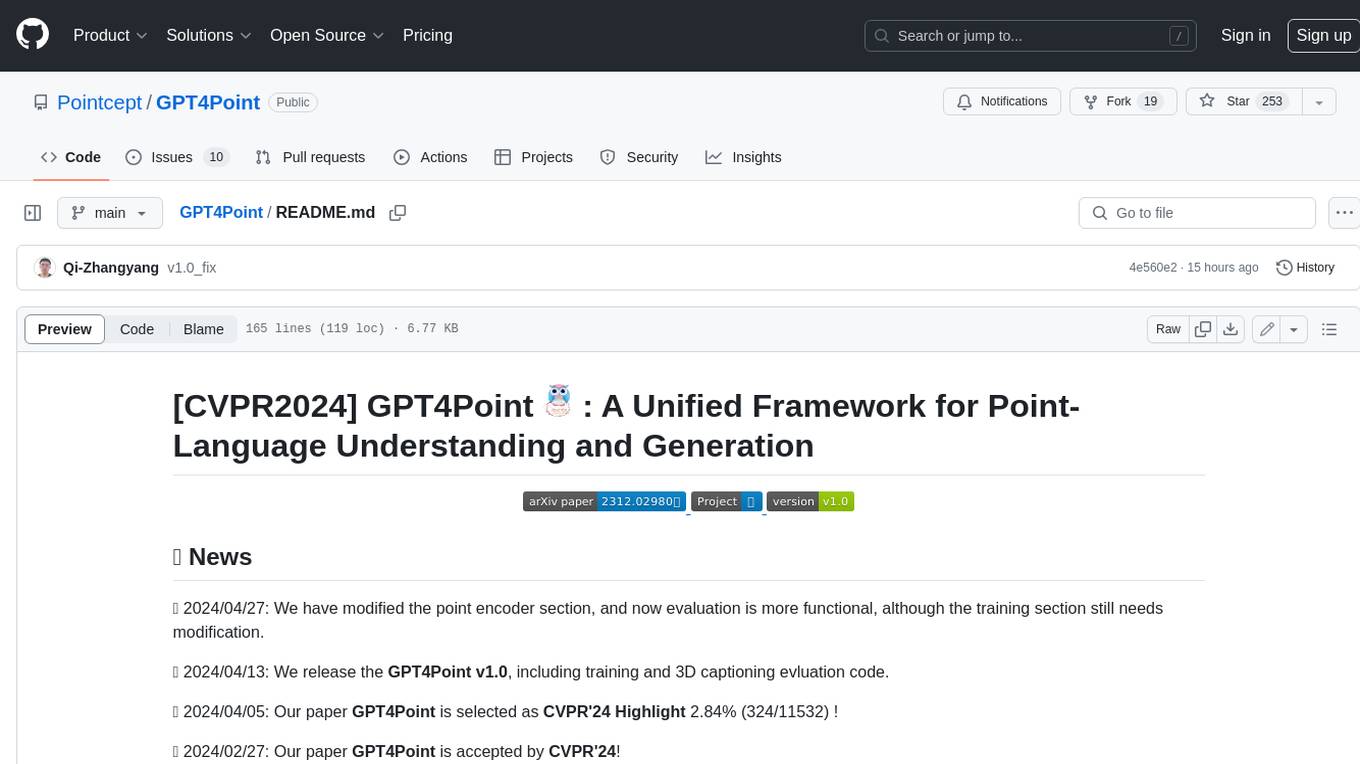
GPT4Point
GPT4Point is a unified framework for point-language understanding and generation. It aligns 3D point clouds with language, providing a comprehensive solution for tasks such as 3D captioning and controlled 3D generation. The project includes an automated point-language dataset annotation engine, a novel object-level point cloud benchmark, and a 3D multi-modality model. Users can train and evaluate models using the provided code and datasets, with a focus on improving models' understanding capabilities and facilitating the generation of 3D objects.
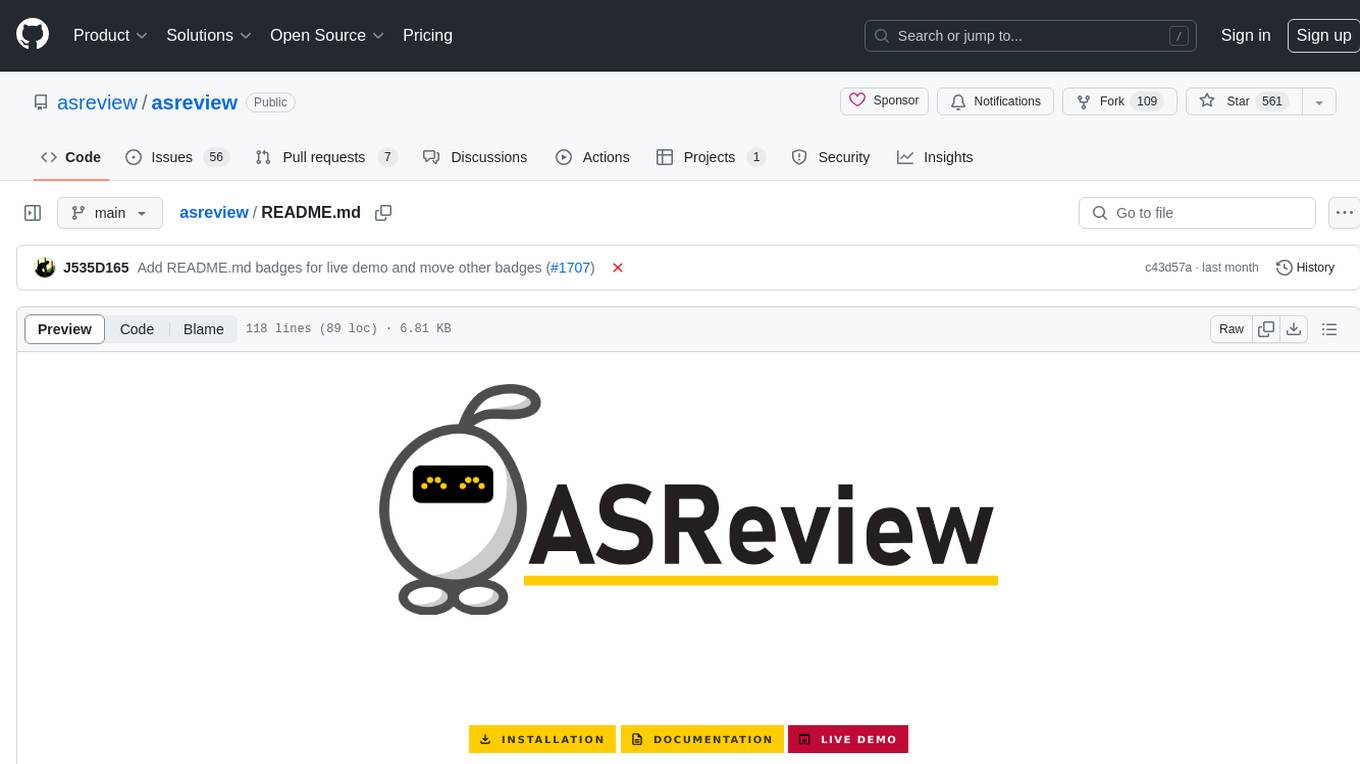
asreview
The ASReview project implements active learning for systematic reviews, utilizing AI-aided pipelines to assist in finding relevant texts for search tasks. It accelerates the screening of textual data with minimal human input, saving time and increasing output quality. The software offers three modes: Oracle for interactive screening, Exploration for teaching purposes, and Simulation for evaluating active learning models. ASReview LAB is designed to support decision-making in any discipline or industry by improving efficiency and transparency in screening large amounts of textual data.
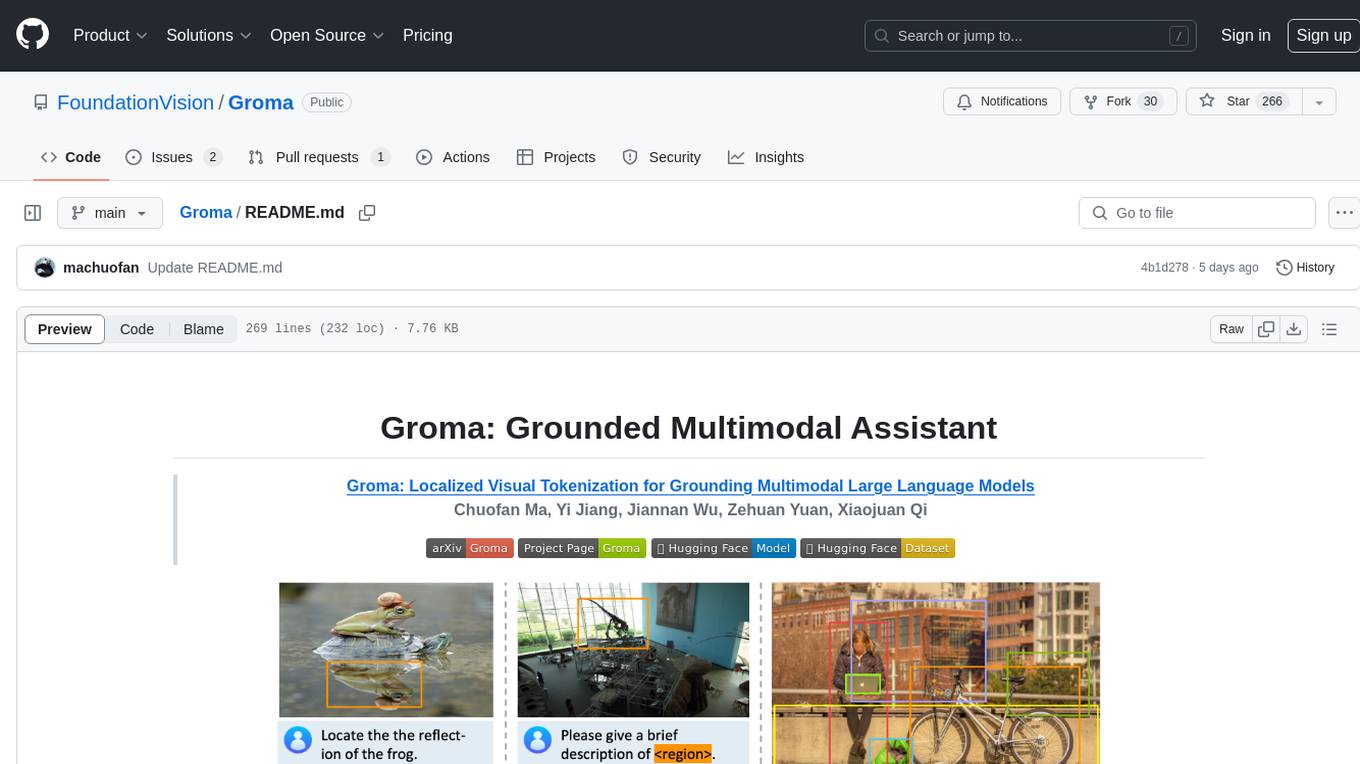
Groma
Groma is a grounded multimodal assistant that excels in region understanding and visual grounding. It can process user-defined region inputs and generate contextually grounded long-form responses. The tool presents a unique paradigm for multimodal large language models, focusing on visual tokenization for localization. Groma achieves state-of-the-art performance in referring expression comprehension benchmarks. The tool provides pretrained model weights and instructions for data preparation, training, inference, and evaluation. Users can customize training by starting from intermediate checkpoints. Groma is designed to handle tasks related to detection pretraining, alignment pretraining, instruction finetuning, instruction following, and more.
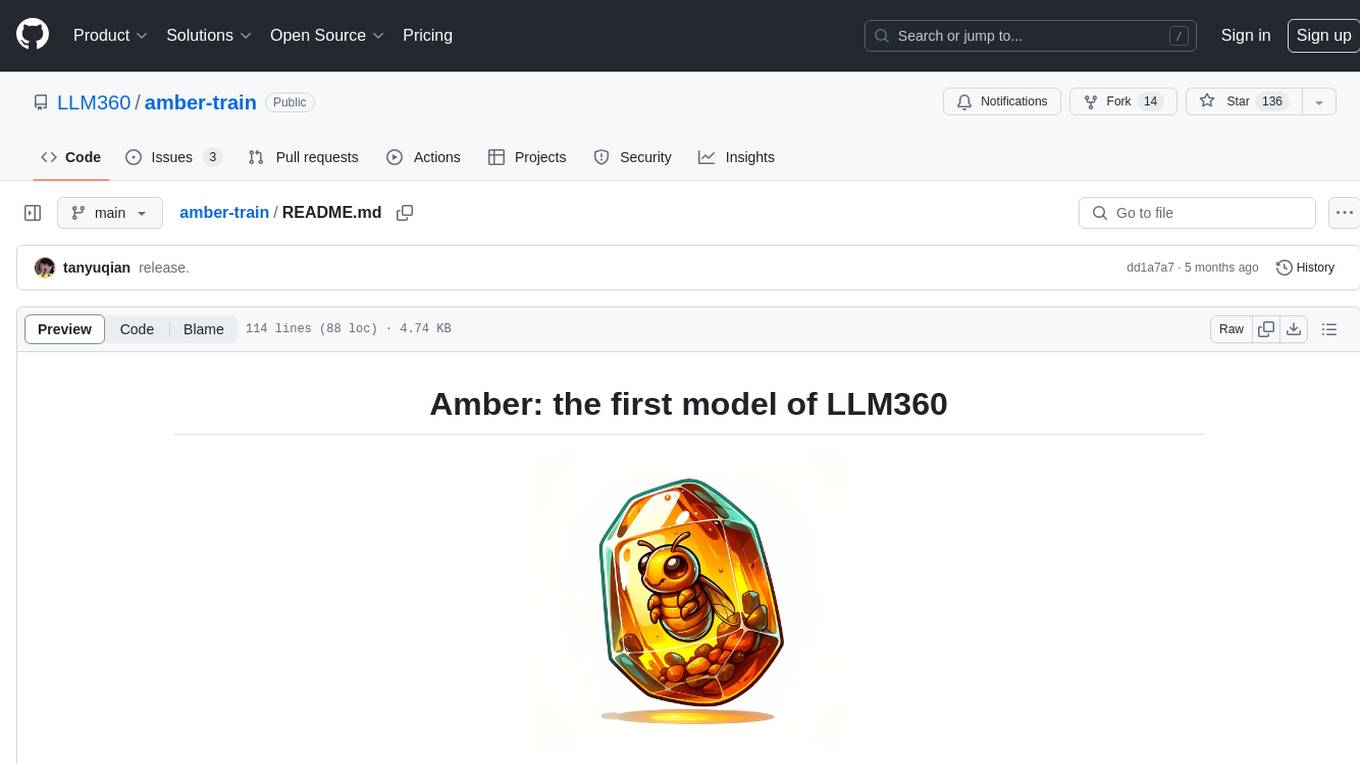
amber-train
Amber is the first model in the LLM360 family, an initiative for comprehensive and fully open-sourced LLMs. It is a 7B English language model with the LLaMA architecture. The model type is a language model with the same architecture as LLaMA-7B. It is licensed under Apache 2.0. The resources available include training code, data preparation, metrics, and fully processed Amber pretraining data. The model has been trained on various datasets like Arxiv, Book, C4, Refined-Web, StarCoder, StackExchange, and Wikipedia. The hyperparameters include a total of 6.7B parameters, hidden size of 4096, intermediate size of 11008, 32 attention heads, 32 hidden layers, RMSNorm ε of 1e^-6, max sequence length of 2048, and a vocabulary size of 32000.
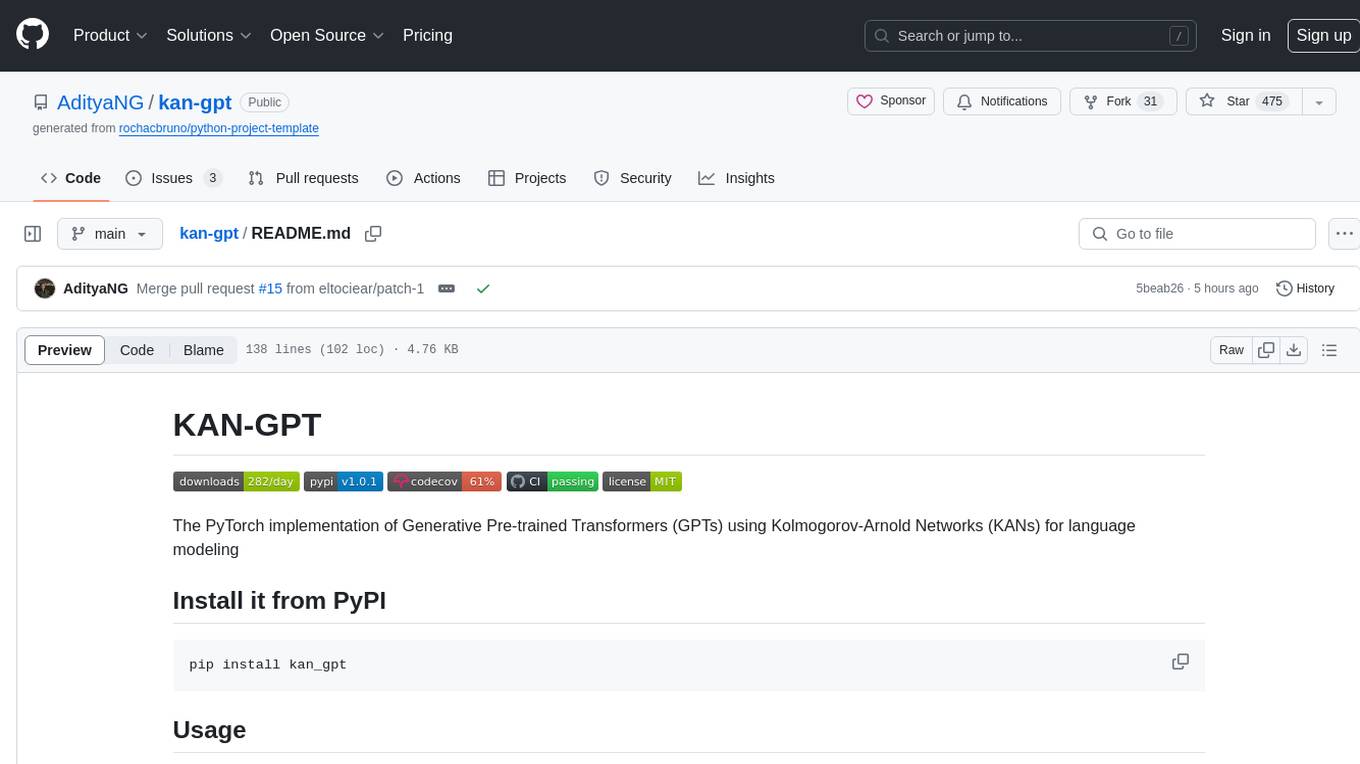
kan-gpt
The KAN-GPT repository is a PyTorch implementation of Generative Pre-trained Transformers (GPTs) using Kolmogorov-Arnold Networks (KANs) for language modeling. It provides a model for generating text based on prompts, with a focus on improving performance compared to traditional MLP-GPT models. The repository includes scripts for training the model, downloading datasets, and evaluating model performance. Development tasks include integrating with other libraries, testing, and documentation.
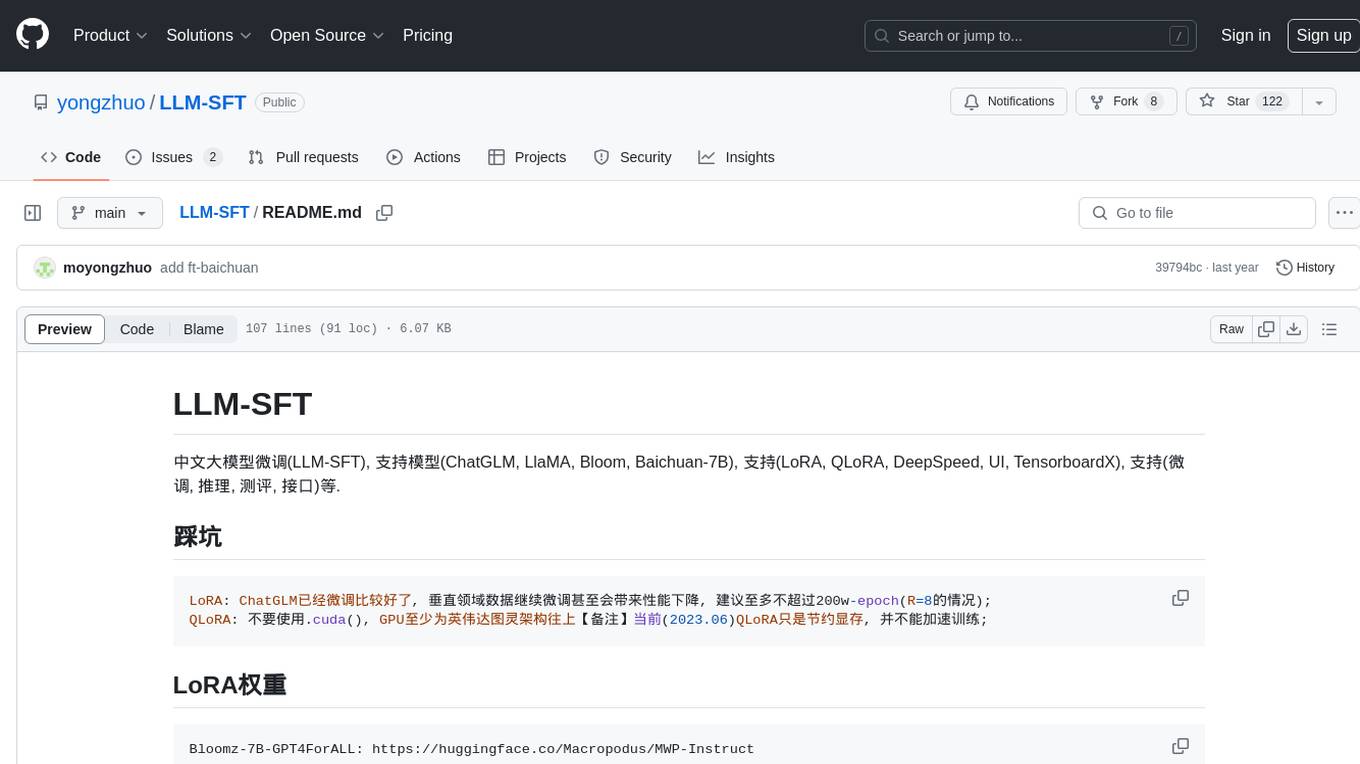
LLM-SFT
LLM-SFT is a Chinese large model fine-tuning tool that supports models such as ChatGLM, LlaMA, Bloom, Baichuan-7B, and frameworks like LoRA, QLoRA, DeepSpeed, UI, and TensorboardX. It facilitates tasks like fine-tuning, inference, evaluation, and API integration. The tool provides pre-trained weights for various models and datasets for Chinese language processing. It requires specific versions of libraries like transformers and torch for different functionalities.
For similar jobs

weave
Weave is a toolkit for developing Generative AI applications, built by Weights & Biases. With Weave, you can log and debug language model inputs, outputs, and traces; build rigorous, apples-to-apples evaluations for language model use cases; and organize all the information generated across the LLM workflow, from experimentation to evaluations to production. Weave aims to bring rigor, best-practices, and composability to the inherently experimental process of developing Generative AI software, without introducing cognitive overhead.

LLMStack
LLMStack is a no-code platform for building generative AI agents, workflows, and chatbots. It allows users to connect their own data, internal tools, and GPT-powered models without any coding experience. LLMStack can be deployed to the cloud or on-premise and can be accessed via HTTP API or triggered from Slack or Discord.

VisionCraft
The VisionCraft API is a free API for using over 100 different AI models. From images to sound.

kaito
Kaito is an operator that automates the AI/ML inference model deployment in a Kubernetes cluster. It manages large model files using container images, avoids tuning deployment parameters to fit GPU hardware by providing preset configurations, auto-provisions GPU nodes based on model requirements, and hosts large model images in the public Microsoft Container Registry (MCR) if the license allows. Using Kaito, the workflow of onboarding large AI inference models in Kubernetes is largely simplified.

PyRIT
PyRIT is an open access automation framework designed to empower security professionals and ML engineers to red team foundation models and their applications. It automates AI Red Teaming tasks to allow operators to focus on more complicated and time-consuming tasks and can also identify security harms such as misuse (e.g., malware generation, jailbreaking), and privacy harms (e.g., identity theft). The goal is to allow researchers to have a baseline of how well their model and entire inference pipeline is doing against different harm categories and to be able to compare that baseline to future iterations of their model. This allows them to have empirical data on how well their model is doing today, and detect any degradation of performance based on future improvements.

tabby
Tabby is a self-hosted AI coding assistant, offering an open-source and on-premises alternative to GitHub Copilot. It boasts several key features: * Self-contained, with no need for a DBMS or cloud service. * OpenAPI interface, easy to integrate with existing infrastructure (e.g Cloud IDE). * Supports consumer-grade GPUs.

spear
SPEAR (Simulator for Photorealistic Embodied AI Research) is a powerful tool for training embodied agents. It features 300 unique virtual indoor environments with 2,566 unique rooms and 17,234 unique objects that can be manipulated individually. Each environment is designed by a professional artist and features detailed geometry, photorealistic materials, and a unique floor plan and object layout. SPEAR is implemented as Unreal Engine assets and provides an OpenAI Gym interface for interacting with the environments via Python.

Magick
Magick is a groundbreaking visual AIDE (Artificial Intelligence Development Environment) for no-code data pipelines and multimodal agents. Magick can connect to other services and comes with nodes and templates well-suited for intelligent agents, chatbots, complex reasoning systems and realistic characters.

